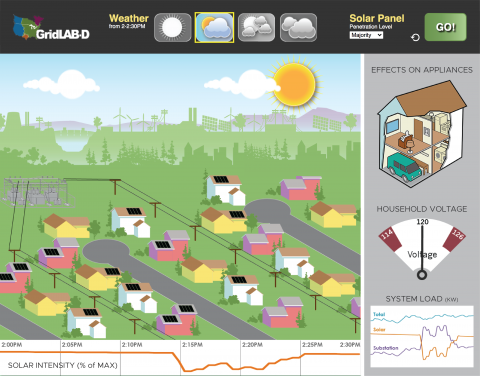In-home storage of electricity-which can be generated by residential solar panels-can save a homeowner money on their electric bills. It also can benefit the electric company and the power grid. That's the takeaway from simulations of residential power use coupled with a battery, directed by a smart controller, conducted by researchers at Pacific Northwest National Laboratory (PNNL).
To study various scenarios, PNNL researchers created a special testbed to run simulations for Orison-a company that developed a plug-in home energy storage system. The self-installable battery stores energy that can be generated by solar panels or other distributed sources. Owners can export this stored energy to the grid when it's not needed or use it to power their own electricity needs at a later time. Orison participated in the American-Made Solar Prize, sponsored by the U.S. Department of Energy Solar Energy Technologies Office. As a finalist, Orison received a voucher for technical assistance from a national laboratory and chose to work with PNNL.
PNNL has decades of expertise in researching the electric grid, grid modeling, and developing co-simulation platforms, which involve linking multiple simulators and data from different domains. PNNL researchers created a testbed to assess the effects of simulated use of Orison's energy storage wall panel on the home and power grid.
"The testbed was composed of a grid model and included detailed simulations of individual electricity use in a 10-home, simulated residential neighborhood, representing varying behaviors and multiple other factors, over specific periods of time," said Andy Reiman, a power systems engineer at PNNL.
Home energy storage simulation
The complex models considered the effects of minute-by-minute interactions between four elements: the home energy storage device; the rooftop photovoltaic solar energy generation system; detailed customer load data; and distribution grid for the neighborhood. The model evaluated conditions against time-of-use pricing representing an actual Southern California market.

Each simulated home had one or more small-scale-2.2kWh-battery modules that would charge or discharge automatically, based on algorithms that PNNL programmed to act as a smart controller.
The PNNL team ran simulations with and without the batteries. They found that by storing solar energy for use during peak loads later on, each house was able to save money. This load shifting in response to time-of-use pricing, which is available to some residential customers, enabled 13-26 percent daily cost savings for the simulated homes. Even when the overall consumption of power was slightly higher, the total cost was much less than pulling from the grid during the peak cost period.
Batteries offer control
The control afforded by the batteries allows homeowners to help level the load on the grid. Variability due to quickly shifting electricity demand-a summer weekday evening when people return home and turn on the air conditioning and appliances like TVs-makes it harder for grid operators to manage voltage and contributes to the cost of electricity. PNNL's simulations found that the batteries were able to reduce peak loads on the grid when households chose to rely on their stored energy during high demand periods.
Additionally, when homeowners choose to charge the batteries during periods of peak sunlight, they avoid exporting this excess energy back to a grid that is typically already flush with electricity at that time of day.
Advancing solar through batteries
"This project is extremely relevant to the electric industry as it clearly reflects how distributed resources on the customer side of the meter have the potential to resolve time-of-use issues and to support greater renewables, while keeping service reliable and cost-effective for consumers," said Eric Clifton, Orison's founder and CEO.
The American-Made Solar Prize, a competition managed by the National Renewable Energy Laboratory, is designed to accelerate and sustain American solar innovation. The prize offers a total of $3 million to competitors, plus technical support vouchers, to energize U.S. solar manufacturing with a powerful support network including national laboratory researchers.
Orison's voucher funded researchers who used advanced simulations and algorithms developed at PNNL to analyze the impact of in-home batteries or 'behind-the-meter' storage on load and voltage variability at the customer level. The results demonstrate a use case for both homeowners and grid operators, adding to the quantifiable benefits of solar energy thereby enabling advancement of this renewable resource.
The findings may also assist household battery system vendors, like Orison, in defining control algorithms to maximize customer value and appropriately size solar inverters and storage capacity.






